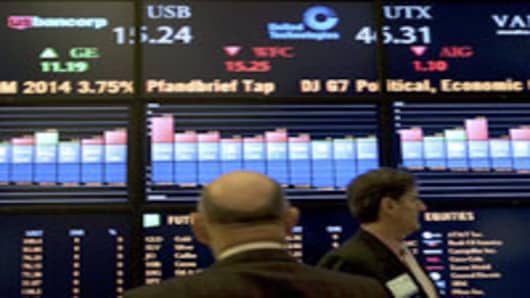If the stock market holds to a pattern it has followed for most of the past 40 years, 2010 could be a big year for investors.
Since 1973, a big advance on the first trading day of January has been a strong sign stocks will post robust gains for the rest of the year.
On Monday, upbeat news about manufacturing lifted the Dow Jones industrial average 155 points, or 1.5 percent. The Standard & Poor's 500 index rose 17 points, or 1.6 percent.
When the S&P 500 has gained more than 1 percent on the first day of trading, the index has ended the year higher 86 percent of the time, according to Schaeffer's Investment Research.
After a big first day, the average yearly gain in the S&P 500 index has been 14.7 percent. That's important because the index is the yardstick for the overall market and for many investments such as mutual funds.
Still, trying to predict the year based on the first day of trading is dicey.
Over the past 20 years, the S&P 500's first-day move regardless of its size correlated with how the index finished the year just 11 times. Six of those years saw the market advance, while five saw it slide.
And as investors are well aware, there are plenty of potential obstacles that could pull the market back down, including Friday's December employment report from the Labor Department.
Other threats include the struggling real estate market and expectations of rising interest rates.
Analysts agree that the huge gains of 2009—when the S&P 500 index jumped 64.8 percent in nine months to end the year with a gain of 23.5 percent—have almost no chance of being
After such a huge run in 2009, some market watchers believe lingering questions about the economy could trigger a correction, which is generally considered a drop of at least 10 percent.
But for those who believe "as January goes in the stock market, so goes the rest of the year," the first trading day of 2010 is a good omen.
China's manufacturing industry posted the fastest growth in 20 months for December, while a trade group of purchasing executives said demand at U.S. factories was increasing. The Institute for Supply Management's index of manufacturing activity rose to 55.9 from 53.6 in November, a bigger improvement than analysts predicted.
The market may also have rallied Monday based on what's known as the "January effect," the buying spurt that often occurs with the start of a new tax year.
Investors who sold stock before the end of the old year to claim a tax loss reinvest that money when trading begins again.
According to the "Stock Trader's Almanac," a book that tracks market trends, there have been only five times since 1950 when the January effect turned out to be a poor indicator of the rest of the year.
The stock market barreled higher in 2009 in part because the big banks at the heart of the 2008 financial crisis started making money again. But much of their ability to do so was dependent on the Federal Reserve, which helped them out with ultra-low borrowing costs.
Investors are uncertain how banks and the rest of the economy will fare as policymakers begin to withdraw some of those emergency supports from the economy this year.
David Kelly, chief market strategist at J.P. Morgan Funds, is looking first at jobs, not statistics, to determine whether the market can hold and even build on the steep advance of 2009.
"The crucial last checkmark on the clipboard of economic recovery is employment," Kelly said.
If unemployment remains at 10 percent, it will be hard for consumer spending to increase and that's what drives the economy.
"Jobs, from an economic psychology point of view, are kind of the holy grail. A lot of people in America don't believe the economy is recovering," Kelly said.
The next major snapshot of the job market comes Friday, when the Labor Department is scheduled to release its employment figures for December.
It is already the biggest report on investors' calendar each month but this one will set the tone for trading in 2010.
Economists forecast that employers cut 23,000 jobs in December, according to a survey by Thomson Reuters. In November, the number of jobs lost came to 11,000 jobs, far fewer than anticipated.
Kelly said a gain in jobs, when it occurs, could send a jolt through the markets.
"That will deal a body-blow to pessimism," he said.
Beyond the worries about the economy, there is a danger that greed could lead the market astray, as it did when the S&P 500 and the Dow reached their peak in October 2007.
The S&P 500 index is still down by 27.6 percent from its high, while the Dow is still down 25.3 percent.
Jeffrey Frankel, president of Stuart Frankel & Co. in New York, is concerned that everyday investors who missed the strong run in 2009 are now charging into the market.
"People sat around the holiday table and those that had money in cash and those that had money in bonds had to listen to people that had money in funds," Frankel said. "Unfortunately that leads to people kind of following the crowd."



